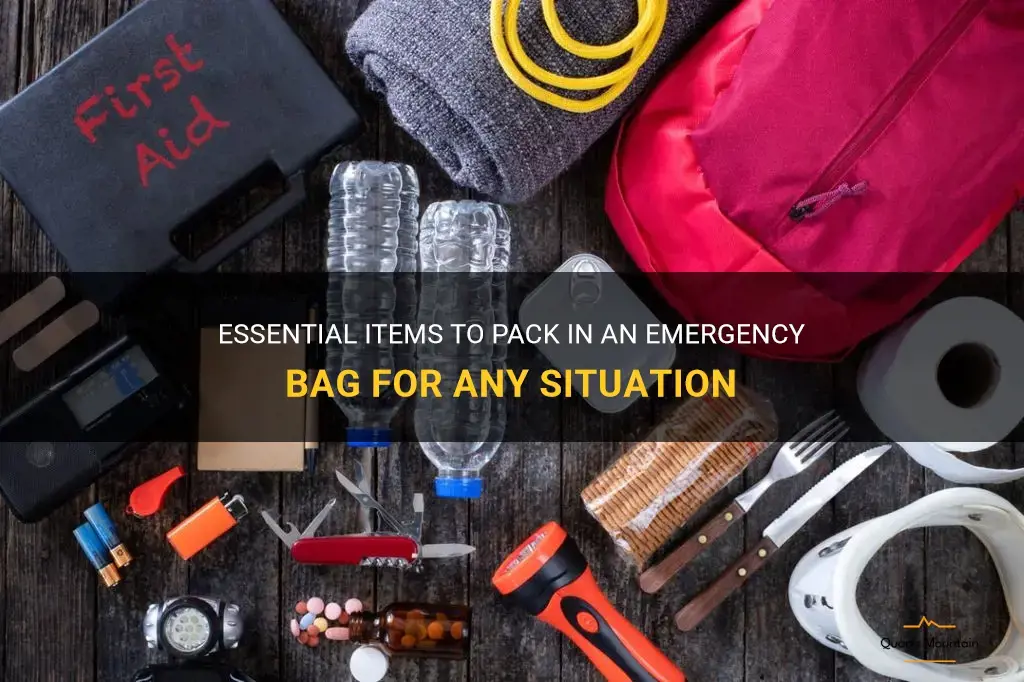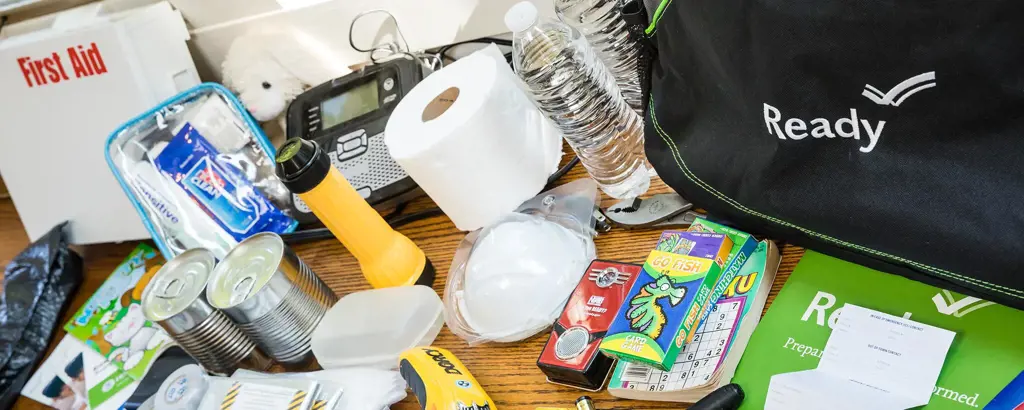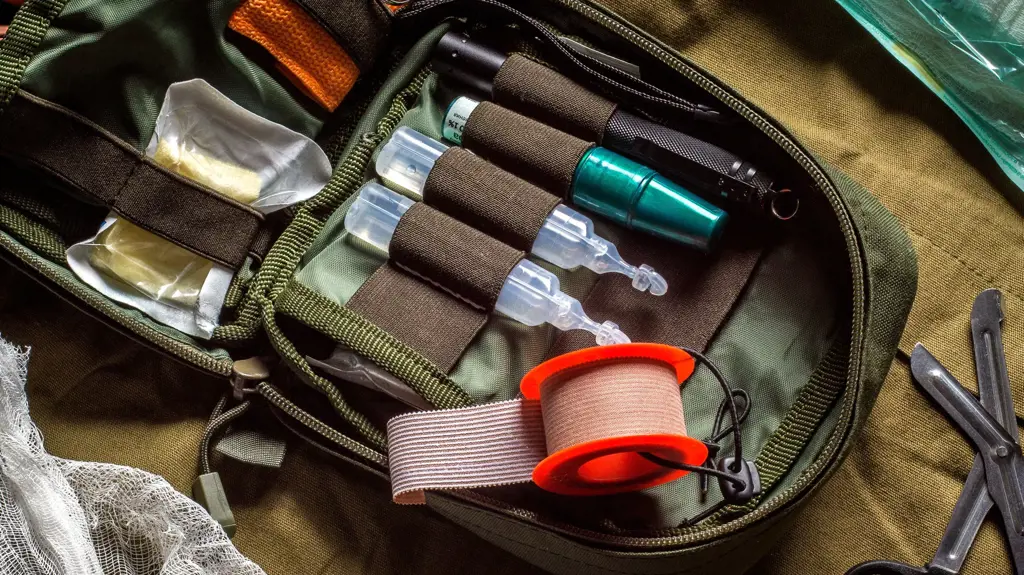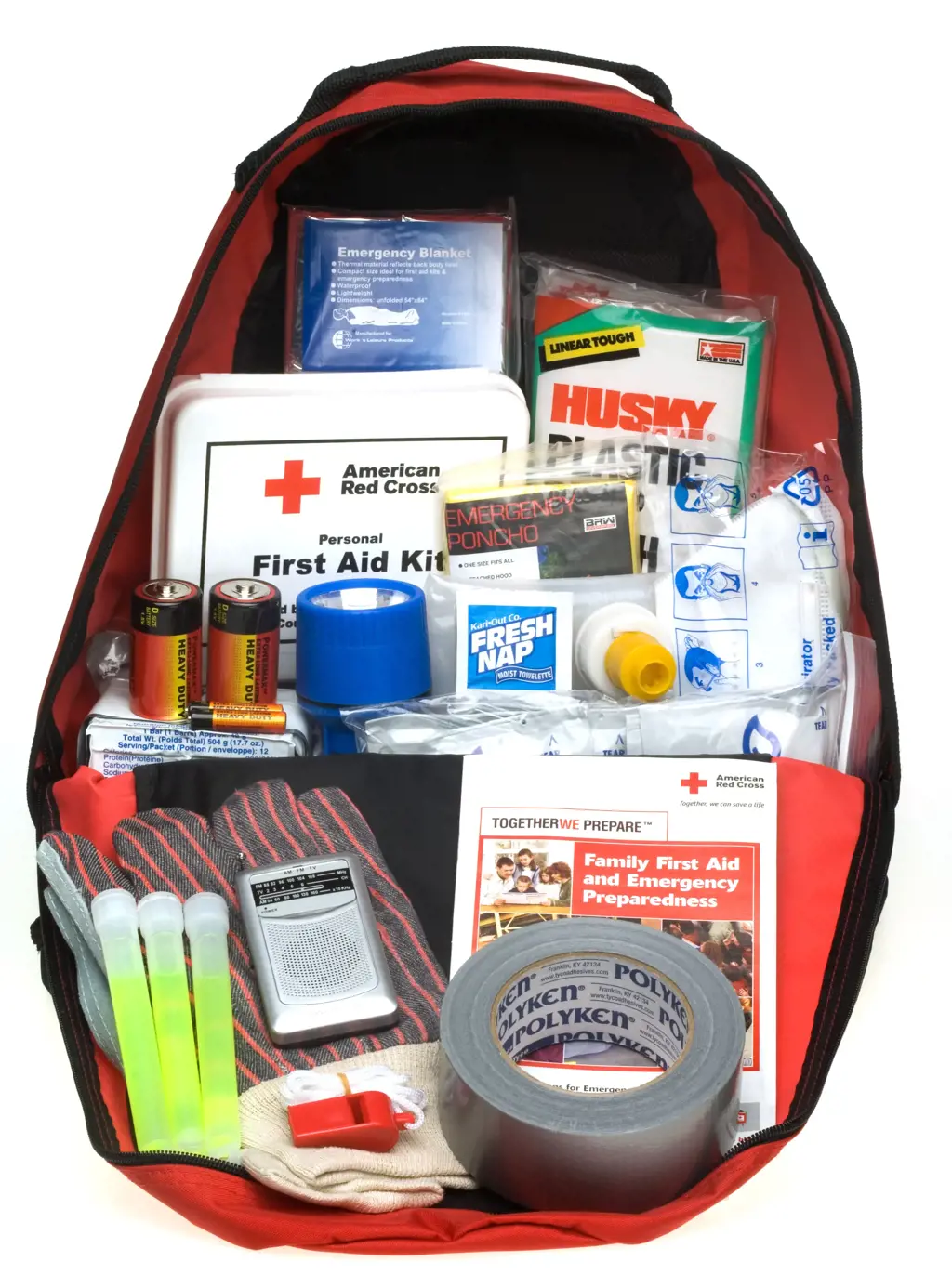
When disaster strikes, it is essential to be prepared and have an emergency bag packed with all the necessary items. Whether it's a natural disaster, a power outage, or even a personal emergency, having a well-equipped emergency bag can make all the difference. In this article, we will explore the essential items that should be included in an emergency bag for any situation. From basic necessities like food and water to important documents and tools, these items will help you stay safe, comfortable, and prepared during an emergency. So let's dive in and ensure that you have everything you need to weather any storm!
| Characteristics | Values |
|---|---|
| Food | Non-perishable, easy-to-open, high in calories |
| Water | At least 1 gallon per person per day |
| Shelter | Tent, sleeping bag, emergency blanket |
| First Aid | Bandages, antiseptic, pain relievers |
| Clothing | Extra clothes, sturdy shoes |
| Light | Flashlights, batteries |
| Communication | Cell phone, charger, radio |
| Tools | Multi-tool, duct tape, rope |
| Personal Items | Cash, identification, medication |
| Extras | Whistle, compass, map |
What You'll Learn
- What essential items should be packed in an emergency bag?
- How much food and water should be included in an emergency bag?
- What medical supplies should be included in an emergency bag?
- Should important documents and personal identification be included in an emergency bag?
- Are there any specific items or tools to pack in an emergency bag for different types of emergencies (e.g. natural disasters, power outages, etc.)?

What essential items should be packed in an emergency bag?

In times of emergency, having a well-stocked emergency bag can be a lifesaver. Whether you're preparing for a natural disaster, a power outage, or even just a roadside emergency, having essential items packed and ready to go can help ensure your safety and comfort. Here are some essential items that should be packed in an emergency bag.
- Water: Water is the most important item to have in an emergency bag. It is recommended to have at least one gallon of water per person per day for drinking and sanitation purposes. Make sure to pack enough water to last for at least three days.
- Non-perishable food: Pack a supply of non-perishable food items such as canned goods, energy bars, and dried fruits. These items have a long shelf life and do not require refrigeration. It is a good idea to have enough food for at least three days.
- Medications: If you or anyone in your family takes prescription medications, make sure to pack a sufficient supply in your emergency bag. Additionally, include over-the-counter medications such as pain relievers, antacids, and allergy medications. Remember to rotate these medications regularly to ensure they do not expire.
- First aid kit: A well-stocked first aid kit is essential in an emergency bag. Include items such as bandages, gauze pads, adhesive tape, scissors, tweezers, and antiseptic wipes. Also, include any necessary personal items such as contact lens solution or hearing aid batteries.
- Flashlight and batteries: A flashlight is crucial in the event of a power outage. Make sure to pack a reliable flashlight and extra batteries. Consider also packing a headlamp for hands-free use.
- Emergency shelter: In case you need to evacuate or find yourself without a home, having emergency shelter supplies is crucial. Pack a lightweight tent or tarp, sleeping bags or blankets, and emergency blankets to stay warm and protected.
- Personal hygiene items: Pack personal hygiene items such as toilet paper, wet wipes, hand sanitizer, and menstrual products. These items will help maintain cleanliness and sanitation during an emergency.
- Important documents: Make sure to keep copies of important documents in your emergency bag. This includes identification cards, insurance information, and emergency contact numbers. It is also a good idea to include a small amount of cash and spare keys.
- Multi-tool and duct tape: Having a multi-tool that includes a knife, pliers, and screwdrivers can come in handy in various situations. Duct tape is a versatile item that can be used for repairs, sealing, and even medical purposes.
- Communication devices: Pack a battery-powered or hand-crank radio to stay informed about the latest updates during an emergency. It is also a good idea to have a cell phone charger or a portable power bank to keep your devices charged.
Remember to regularly check and update your emergency bag to ensure that all items are in good condition and that they meet the needs of you and your family. By being prepared and having these essential items packed in your emergency bag, you can have peace of mind knowing that you are ready for any emergency situation.
Essential Packing List for a Memorable Girls' Weekend Getaway
You may want to see also

How much food and water should be included in an emergency bag?

In times of emergency, having an emergency bag prepared with essential supplies is crucial. One of the most important components of an emergency bag is food and water. These provisions are necessary to sustain individuals until help arrives or until they can find alternative sources of sustenance. However, determining the amount of food and water to include in an emergency bag can be a challenging task. Let's explore this topic further to understand how much food and water should be included in an emergency bag.
Scientifically speaking, the human body requires a certain amount of calories and fluids to function optimally. According to the U.S. Department of Agriculture, an average adult needs roughly 2,000 to 2,500 calories per day, depending on age, gender, and activity level. In emergency situations where individuals may be more physically active or under stress, their caloric needs may increase. Therefore, it is recommended to include food items that provide at least 2,000 calories per day in an emergency bag.
When it comes to water, the general rule is to have at least one gallon (3.78 liters) of water per person per day. This amount encompasses drinking, cooking, and basic hygiene needs. However, the quantity of water needed may vary based on various factors such as the climate, physical exertion, and individual needs. It is advisable to store a sufficient supply of water to last for at least three days in an emergency bag. If possible, it would be better to have a week's worth of water supply to ensure longer-term survival.
In addition to considering the scientific recommendations, it is valuable to rely on personal experiences and adapt the quantities based on individual requirements. For instance, if someone has specific dietary restrictions, such as being vegetarian or having food allergies, it is essential to include suitable food options in the bag.
To determine the exact amount of food and water to pack, a step-by-step approach can be followed. Firstly, calculate the number of days the emergency bag is intended to sustain a person or a group of people. Multiply this number by the daily recommended intake of calories and water to estimate the total quantities required. Next, consider the weight and space limitations of the bag to ensure it remains portable and manageable. Opt for lightweight and non-perishable food items such as energy bars, canned goods, dried fruits, and nuts. Additionally, pack water in sturdy containers that are leak-proof and easily transportable.
To illustrate this further, let's consider an example. Suppose an emergency bag is designed to sustain two individuals for three days. Based on the recommended calorie intake of 2,000 calories per day, the total caloric requirement for both individuals would be 12,000 calories (2,000 calories/person/day x 2 people x 3 days). As for water, they would need at least six gallons of water for the three-day period (1 gallon/person/day x 2 people x 3 days). Considering space and weight restrictions, the food can be selected accordingly, and water can be packed in compact, durable containers.
In conclusion, the amount of food and water to include in an emergency bag should be based on scientific recommendations, personal experiences, and a step-by-step approach. By considering factors such as caloric needs, water requirements, dietary restrictions, and weight limitations, individuals can ensure they have an adequate supply of sustenance for themselves and their loved ones during emergency situations. Remember, being prepared can make a significant difference in ensuring survival and well-being in difficult times.
The Best Materials to Use for Packing Your Belongings
You may want to see also

What medical supplies should be included in an emergency bag?

Preparing an emergency bag or a first aid kit is essential for any household or individual, as emergencies can happen at any time. It is important to have the necessary medical supplies on hand to address common injuries or illnesses that may occur in emergency situations. Here are some recommended medical supplies to include in your emergency bag:
- Adhesive bandages: Adhesive bandages, also known as bandaids, are a must-have in any first aid kit. They are used to cover small cuts, scrapes, or blisters to protect them from dirt and bacteria.
- Sterile gauze pads: These are used for larger wounds that cannot be covered by adhesive bandages. Sterile gauze pads are designed to absorb blood and prevent infection. They should be included in your emergency bag in different sizes, from small to large, to address various wound sizes.
- Antiseptic wipes: Antiseptic wipes are used to clean wounds before applying any bandages or dressings. They help reduce the risk of infection by killing bacteria on the skin.
- Disposable gloves: Disposable gloves are essential to protect yourself and the person you are helping from any potential infection. They should be latex-free to accommodate individuals with latex allergies.
- Tweezers: Tweezers are useful for removing splinters or foreign objects from the skin. They should be included in your emergency bag to address minor injuries that may occur.
- Scissors: Scissors are necessary to cut tape, gauze, or clothing if needed. They should have rounded tips to prevent accidental injuries.
- Antibiotic ointment: Antibiotic ointment, such as Neosporin, can be applied to minor wounds to prevent infection and promote healing. It should be used after cleaning the wound with antiseptic wipes.
- Pain relievers: Non-prescription pain relievers, such as acetaminophen or ibuprofen, should be included in your emergency bag to address headaches, fever, or minor aches and pains.
- Cold packs: Cold packs are helpful for relieving pain, reducing swelling, and controlling bleeding in case of injuries. They can be stored in the freezer and activated when needed.
- CPR mask: A CPR mask is essential in case of a medical emergency that requires cardiac resuscitation. It provides a barrier between the responder and the patient, preventing the transmission of infectious diseases.
- Thermometer: A digital thermometer should be included in your emergency bag to monitor body temperature, especially in case of fever or illness.
- Prescription medications: If you or someone in your household is on prescription medication, it is important to have a supply of those medications in your emergency bag. Make sure to check expiration dates regularly and replace any expired medications.
It is crucial to regularly check and replenish your emergency bag's medical supplies to ensure they are not expired or depleted. Additionally, consider taking a first aid training course to gain knowledge and confidence in using these supplies effectively in emergency situations. Remember to always consult a healthcare professional for specific medical advice or emergencies.
The Ultimate Packing Guide for a May Trip to Vegas
You may want to see also

Should important documents and personal identification be included in an emergency bag?

When it comes to emergency preparedness, creating an emergency bag is a crucial step. This bag should contain essential items that will help you and your family survive for at least 72 hours in case of an emergency. While many people focus on including food, water, and first aid supplies in their emergency bags, they often overlook the importance of including important documents and personal identification. In this article, we will discuss why it is crucial to include these items in your emergency bag.
First and foremost, important documents such as passports, birth certificates, social security cards, and insurance papers are essential in an emergency situation. These documents serve as proof of identity and may be necessary for accessing various services during and after an emergency. For example, if you need to apply for government assistance or access your bank accounts, having these documents readily available will make the process much easier. Additionally, if you need to evacuate your home, having these documents with you can help establish your identity and facilitate communication with authorities.
Personal identification, including driver's licenses and identification cards, should also be included in your emergency bag. These documents are important for many reasons. In an emergency, you may need to prove your identity to access certain areas or receive assistance. Additionally, if you need to seek medical treatment, having your identification with you will help medical professionals accurately identify and treat you.
When including important documents and personal identification in your emergency bag, it is important to keep them secure and protected from damage. Consider storing them in a waterproof, fireproof container to ensure their safety. You can also make copies of these documents and store them digitally on a USB drive or cloud storage, which can be accessed remotely if needed.
In addition to important documents, it is also a good idea to include other important personal items in your emergency bag. These may include contact information for family and friends, medical records, important passwords, and a list of allergies or medical conditions. These items can be crucial in ensuring your safety and well-being during and after an emergency.
In conclusion, including important documents and personal identification in your emergency bag is crucial. These documents serve as proof of identity and may be necessary for accessing services and assistance during an emergency. Make sure to keep them secure and protected from damage. Additionally, consider including other personal items that may be important for your safety and well-being. By being prepared and having these items readily available, you can ensure that you and your family are well-equipped to handle any emergency that may arise.
Essential Items to Pack for Your Havasupai Falls Hike
You may want to see also

Are there any specific items or tools to pack in an emergency bag for different types of emergencies (e.g. natural disasters, power outages, etc.)?
_20231125110440.webp)
When it comes to preparing for emergencies, having an emergency bag with essential items is crucial. The exact contents of the bag may vary depending on the type of emergency you are preparing for, whether it's a natural disaster, power outage, or other situations. In this article, we will discuss some specific items and tools to pack in an emergency bag for different types of emergencies.
Natural Disasters:
Natural disasters can encompass a wide range of events such as hurricanes, earthquakes, floods, and wildfires. For these types of emergencies, it is essential to have the following items in your emergency bag:
- Water and non-perishable food: Pack enough water and food to sustain yourself and your family for at least three days. Choose lightweight, nutrient-rich items that require minimal preparation.
- First aid kit: Include basic medical supplies such as bandages, antiseptics, pain relievers, and any necessary prescription medications.
- Flashlights and batteries: Ensure you have multiple flashlights and extra batteries. LED flashlights are a good choice as they are more energy-efficient.
- Portable phone charger: In case of power outages, having a fully charged portable phone charger can help you stay connected and call for help if needed.
- Emergency blanket and clothing: Pack a lightweight emergency blanket and extra clothing suitable for the climate. Include rain gear, sturdy shoes, and warm clothing if necessary.
- Whistle and signaling devices: These can be used to attract attention if you are in need of help.
Power Outages:
Power outages can occur due to severe weather conditions, equipment failure, or other unforeseen circumstances. To prepare for a power outage, consider packing the following items in your emergency bag:
- Battery-powered or hand-crank radio: A radio will help you stay informed about the situation and receive important updates from authorities.
- Extra batteries: Have a supply of extra batteries on hand for your flashlights, radio, and other battery-powered devices.
- Non-perishable food and can opener: Include easy-to-eat, non-perishable food items that do not require refrigeration or cooking. A manual can opener is essential if you have canned goods.
- Warm blankets and extra clothing: Without power, your home may get cold, so pack extra blankets and warm clothing to keep yourself warm.
- Cash: Keep a small amount of cash on hand as ATMs and credit card machines may not be functional during a power outage.
- Water: If you rely on an electric pump for your water supply, have extra bottled water stored in your emergency bag.
Other Emergencies:
In addition to natural disasters and power outages, there are several other types of emergencies that may require you to have an emergency bag. These can include situations like civil unrest, evacuation, or accidents. Consider including the following items:
- Important documents: Keep copies of essential documents such as identification cards, passports, insurance policies, and emergency contacts in a waterproof bag.
- Multi-tool: A multi-tool can be handy in various situations where you may need to fix or open things.
- Duct tape and plastic sheets: These items can be used for temporary repairs or creating a makeshift shelter.
- Personal hygiene items: Pack basic personal hygiene items such as toothbrushes, toothpaste, toilet paper, and hand sanitizer.
- Entertainment: In case you end up in a shelter or a situation where you have to wait for an extended period, pack some books, playing cards, or other forms of entertainment.
It is important to periodically check and update the items in your emergency bag. Ensure that your bag is easily accessible and that everyone in your household knows its location. Additionally, consider the specific needs of each family member, such as infants, elderly individuals, or individuals with medical conditions, and pack accordingly.
Remember, the specific items and tools in your emergency bag may vary depending on your location, climate, and personal circumstances. It is always a good idea to consult local authorities or emergency management agencies for specific recommendations tailored to your area. Being prepared and having an emergency bag can greatly increase your chances of staying safe and comfortable during emergencies.
Essential Items to Pack for a Mediterranean Cruise in September
You may want to see also
Frequently asked questions
In an emergency bag, it is important to pack essentials that will help you survive for at least 72 hours. Some of the items you should include are non-perishable food, water, a first aid kit, a flashlight with extra batteries, a multi-purpose tool, a whistle to signal for help, a portable phone charger, personal hygiene items, cash, and important documents such as identification and insurance papers.
The general rule of thumb is to pack one gallon of water per person per day. This should provide enough water for drinking, cooking, and hygiene purposes. It is important to regularly check and replace the water in your emergency bag to ensure its freshness and availability when needed. Additionally, consider packing water purification tablets in case you need to source water from alternative sources.
When packing food for an emergency bag, focus on non-perishable items that are easy to prepare and provide necessary nutrients. Canned goods, energy bars, dried fruits and nuts, and ready-to-eat meals are good options to consider. Remember to also pack a manual can opener if you include canned foods. Be sure to regularly check the expiration dates of the food in your emergency bag and rotate them out as needed.
Absolutely! A first aid kit is an essential item to have in an emergency bag. It should contain bandages, adhesive tape, antiseptic wipes, pain relievers, tweezers, scissors, disposable gloves, and any necessary prescription medications. Consider adding a first aid manual or guidebook to help you provide basic medical care in case of injuries.
It is important to store your emergency bag in a cool, dry place that is easily accessible. Avoid storing it in areas that are prone to flooding or extreme temperatures. Make sure everyone in your household knows where the emergency bag is located and how to access it quickly. Additionally, periodically check the contents of your emergency bag to ensure everything is in working order and to replace any expired items.







